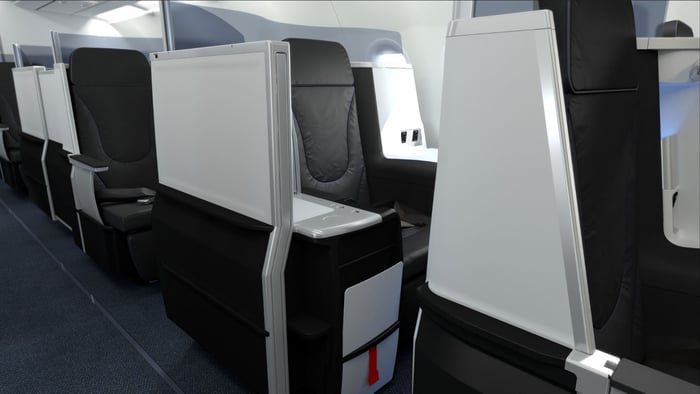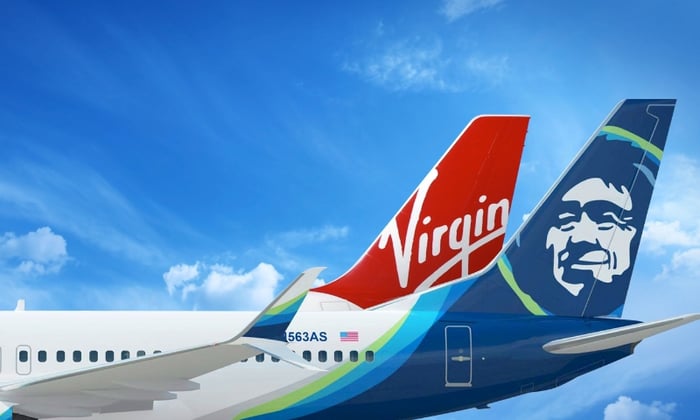Two years ago, JetBlue Airways (JBLU -3.12%) tried to buy trendy West Coast rival Virgin America. However, it ultimately lost a bidding war to Alaska Air (ALK -1.89%), which was eager to expand its strong position in the Pacific Northwest to the rest of the West Coast.
JetBlue responded with an aggressive plan to gain market share on transcontinental routes. The linchpin of this strategy was the expansion of Mint -- JetBlue's highly acclaimed premium service -- to a slew of new routes. So far, this strategy has been extremely successful, and it is putting a ton of pressure on Alaska Air in the transcontinental market.
Bringing Mint to more routes
JetBlue's Mint flights operate with a fleet of Airbus A321s equipped with a 16-seat premium cabin featuring lie-flat seats. Customers who buy these premium seats are treated to gourmet meals, attentive service from two dedicated flight attendants, and various other luxurious amenities.

JetBlue's Mint premium service has won rave reviews from customers. Image source: JetBlue Airways.
Mint aircraft also have 143 coach seats, including seven rows of extra-legroom seats. Even customers flying coach benefit from upgrades like bigger TVs with more free channels and a self-service snack bar.
Initially, JetBlue created Mint in order to compete more effectively with rivals in the New York-Los Angeles and New York-San Francisco markets. (Prior to 2014, JetBlue was an all-coach airline, whereas its rivals were offering upgraded first class service on those two transcontinental routes.) Mint quickly surpassed management's expectations by a wide margin. As a result, JetBlue expanded Mint to its Boston-Los Angeles and Boston-San Francisco routes in 2016.
After losing the bidding war for Virgin America, JetBlue decided to aim even higher with Mint. In the past year, it has introduced Mint service on seven additional transcontinental routes: Fort Lauderdale-Los Angeles, Fort Lauderdale-San Francisco, New York-Las Vegas, New York-San Diego, Boston-Las Vegas, Boston-San Diego, and Boston-Seattle. New York-Seattle Mint service will begin next month. Alaska Air currently competes on six of these eight routes.
Alaska Air feels the pinch
In the past few quarters, Alaska Air's profitability has deteriorated dramatically. Management has pointed to unit revenue weakness on California transcontinental routes as a key factor behind the recent earnings slump. Of course, eight of JetBlue's transcontinental routes touch California.

Alaska Air's Virgin America subsidiary has faced severe fare pressure recently. Image source: Alaska Air.
In some cases, fare levels in these markets have become detached from supply and demand trends. However, JetBlue is also putting downward pressure on economy fares on some routes by adding capacity. It can afford to do so because the Mint premium cabin generates a lot of revenue on its own and because offering more flight options allows JetBlue to gain market share among business travelers, who tend to pay higher fares.
Alaska Air is finally starting to retreat in the face of JetBlue's assault. It recently decided to drop its Fort Lauderdale-San Francisco route for the summer season and cut back to one daily flight on the Fort Lauderdale-Los Angeles route. (Today, it operates two daily flights on both routes, as does JetBlue.)
Given that there aren't many other competitors on these two routes, there is a pretty clear link between JetBlue's upgrade to Mint service and Alaska Air's recent struggles on California transcontinental routes.
Look for JetBlue to consolidate its advantage
On each of its first four Mint transcontinental routes, JetBlue has increased its flight frequency over time. Alaska Air's decision to reduce service on its San Francisco-Fort Lauderdale and Los Angeles-Fort Lauderdale routes has opened up a great opportunity for JetBlue to add a third daily flight in both of those markets. This would help it continue to build its relevance with business travelers.
Looking further ahead, Alaska Air may also struggle to compete against JetBlue's Mint service on the Boston-San Diego and New York-Las Vegas routes. Only in its hometown of Seattle does it have a big enough base of loyal customers to weather a JetBlue Mint expansion with no ill effects.
JetBlue has a clear opportunity to cash in over the next year or two as Mint wins fans in its new markets. By contrast, Alaska Air faces some tough decisions about whether to continue retrenching or to shift strategies and upgrade its first class experience in a big way.




